As the experience of illusionists shows, to learn simple tricks with a coin, you need at least 10 minutes of practice per day. The main thing on this path is always regularity of training and constant improvement. Some tricks with a coin require much less strength and enthusiasm, which is what captivates beginners.
Trick with a coin in hand
Coin tricks for beginners are spectacular but not difficult actions, as in the coin in hand trick, where a coin hidden in the fist of one hand is taken out from the area located under that hand.
How it is done:
- The left hand is open and shows a blank surface. In the right hand, the coin is between the index finger and thumb, touching them with its edges.
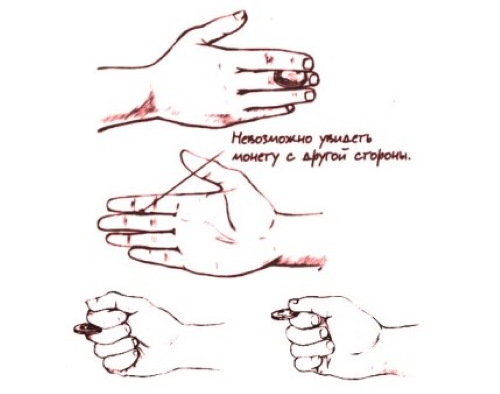
In this state, you need to place your right hand above your left, squeeze the coin with the aforementioned fingers so that the space between them is not visible to the viewer. The coin is squeezed and grasped by one edge facing the thumb.
- In a simplified form, it can be described as follows: the coin is pressed on the edge with the thumb, then the index finger is moved slightly to the side and it is as if the ground is moving away from under the coin’s feet.
- It is better to keep the middle, ring and little fingers spread out so as not to arouse unnecessary suspicion in the viewer, to cover the hidden inventory as much as possible. After this, a quick movement of closing the palm follows.
- The left hand is closed with the illusion of hiding the coin in it. The right hand is moved to the area under the left closed palm.
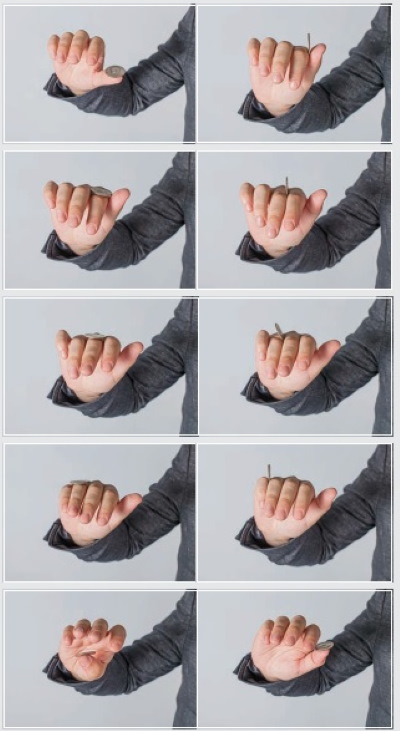
- The hand is drawn under the arm in exactly the same angle as the right hand was previously positioned. When the right hand with the coin is already under the left, the fingers of the right hand (middle, ring and little fingers) are quickly gathered into a fist.
- Next, the magician performs the final enchanting action, namely, he pulls out the coin by pressing with the middle finger on the exit of the coin from the area of the double bundle (thumb, index) with its simultaneous rotation, carried out with the entire tip of the right hand.
The coin should turn out to be an impressive turn for an outside observer.
The Coin Behind the Ear Trick
The essence of the trick is that a coin, shown to the spectator in one hand, moves to the other and disappears in the blink of an eye. The next moment, the coin appears behind the spectator's ear.
How it is done:
- The free left hand is used to divert the viewer's attention. In the right hand is a coin, the edges of which are held by 4 fingers, all except the little finger. The first action with the disappearance is called the "French drop". This useful action can be used as a base for various variations of tricks with a coin.
- The coin in the right hand is covered by the free left hand in the form of a conventional claw. The claw consists of two components, where the thumb is inserted into the empty space of the right hand, and all the other fingers of the improvised claw hang over the upper part of the right hand with the coin.
- Next, the coin is released with the thumb of the right hand, and it carefully falls into the middle place of three tightly connected fingers: the middle, ring and little fingers. This average place of three fingers is called the "finger palm" for simplicity.
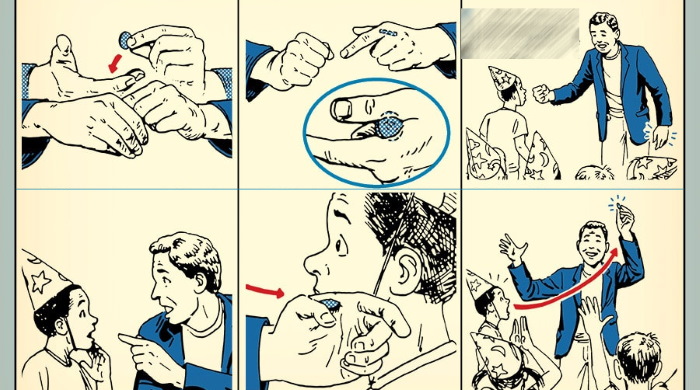
- The thumb of the left hand, placed under the right palm for convenience, can play the role of a kind of support in the necessary fixation of the fallen coin in the “finger palm” gesture.
- For maximum effect, it is important to perform this trick at a 45° angle. The movement of the entire left hand should resemble a full grasp of the coin from the right hand. The fake maneuver is reinforced by clenching the fingers into a fist, and after a few moments of the hand trembling in the air, the open palm shows an empty surface.
- The final element of the whole trick is the appearance of a coin from behind the spectator's ear.
While everyone's eyes are glued to the empty hand and the puzzled expression on the magician's face, the coin must be moved with a slight movement closer to the fingertips (which are in the "finger palm" gesture of the right hand) and touch the spectator's ear. After touching, to everyone's surprise, the coin safely comes out from behind the person's ear.
Trick with a coin and a bottle
Coin tricks for beginners sometimes require special equipment preparation, as in the coin and bottle trick.
At first, the viewer sees only an empty plastic bottle in front of him. The magician demonstratively exposes the bottle, shakes it, opens the cork, under which there is nothing. The magician counts to 3, hitting the bottom of the whole bottle, and on the third attempt throws a coin inside with a crash.
Inventory
In this trick, the preliminary preparation of all its elements plays a big role - 2 coins and a special bottle:
- A simple plastic bottle with any diameter of the neck and cork will do. But for greater spectacle, a bottle with a narrow diameter of the upper part, relative to the coin, is recommended.
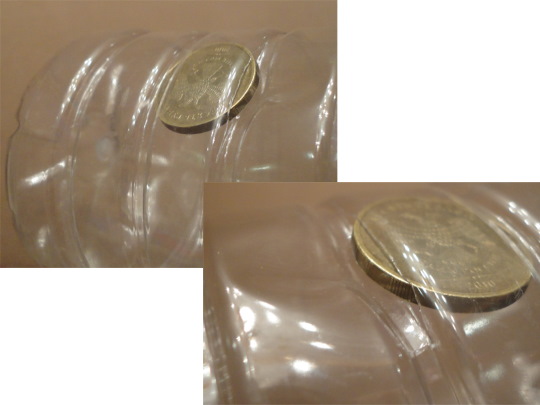
- The ideal option would be to work with a large coin. A bottle with a label in the middle will hide the defect left by the magician well, namely, a small slit necessary for the tight entry of almost the entire coin, firmly hanging in the slit.
The essence of the trick
The magician shows the audience an empty bottle, freely swinging it in the air. The lid is unscrewed and it is also shown that there is nothing inside. The emphasis is placed on the fact that the bottle has a bottom, that the coin cannot pass through a tangible barrier. The goal of the trick is to pass the coin through the bottom of the bottle, which seems impossible.
For greater effect, it is better to do the trick while counting - 1, 2, 3. In one hand is a bottle, in the other - a coin. At the moment of the first touch of the hand with the coin on the plastic bottom, nothing happens, at the moment of the second touch also nothing, but the next time a miracle happens - the coin ends up in the bottle.
What's the secret?
During the first two shakes of the bottle, the second coin, hanging on the side of the bottle facing the magician, is still in the hiding place. As soon as the third blow to the bottom is deliberately strong, the bottle rings with the coin inside.

The third blow is also accompanied by a hidden movement of the thumb of the hand invisible to the spectator, pushing the coin into the slot to the end. When the spectator is amazed, one must discreetly hide the first (showy) coin in one's pocket using palming (squeezing the coin in the middle of the palm).
This is a sleight of hand job that should be practiced in front of a mirror. In addition to the pocket, to conceal it, you can consider the option of discreetly throwing a coin into a pre-prepared place.
Coin and glass trick
In the first version of the trick, the magician has a coin and an empty glass of any size in his hands. The integrity of the glass is demonstrated to the spectator. The first few knocks on the bottom of the glass do not bring success in passing through the glass, a characteristic ringing is heard. On the third knock, the coin is already ringing inside the glass.
The second version of the trick starts with the same components. The viewer sees a coin moved from one hand to another. And then it appears in the glass, as if from thin air, but not from the hand to which it was moved earlier.
This trick is not fundamentally different from the trick of passing a coin through the bottom of a glass, only the method of achieving the goal changes.
So, the trick with a coin and a glass can be done in two ways:
- using precise calculation of the path of a flying coin;
- using the "French reset".
Coin trick for beginners in the first version
A regular glass is taken in one hand, and a coin in the other. To overcome the glass bottom of the glass, a count of "3" attempts is also required. The first "2" are characterized by cutting the distance to the bottom with the right hand holding a coin clenched into a fist. Only when approaching the bottom does the fist unclench, and the open palm with the ringing coin hits the glass.
In both cases, the coin is exactly in the middle of the palm. On the count of "3", the coin is thrown to the fingertips so that when it collides, it flies out of the right hand and hits the inside of the palm of the left hand holding the glass.
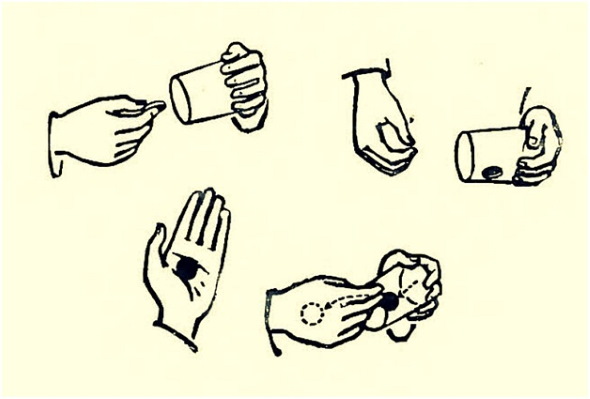
The actions of the left hand at this time consist of holding the glass not at a right angle, but at an angle of 45°, relative to the upper edge of the glass, so that the coin will find the necessary space to perform the maneuver.
The trick looks lively in dynamics, but it is recommended not to show it several times in one company, otherwise exposure is inevitable. This process of tossing a coin should be trained thoroughly, only a perfectly verified position of the hands can become a guarantee of successful tricks, especially for beginners.
The coin trick in the second version
Now the trick begins with the imitation of grabbing a coin from one hand to the other (the "French Flip"):
- The coin is in the right hand, the magician makes a deceptive movement and turns his attention to the left hand. At this time, the coin continues to be in a comfortable position of palming the fingers of the right hand. The glass is grabbed with the right hand (with a grip from above).
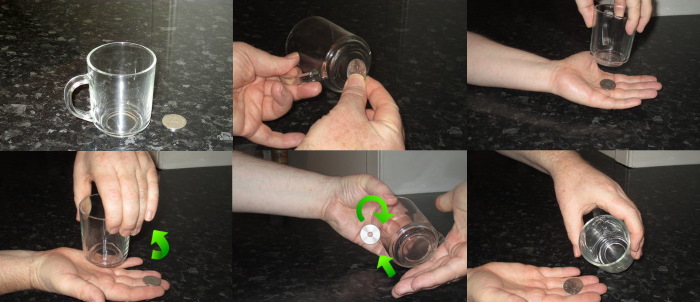
- The left hand, clenched into a fist, makes the motion of hitting the bottom without unclenching.
- The last - third movement is carried out with the palm open to the glass, and from the right hand (holding the glass with the palming element) a coin falls into the container, supposedly launched from the bottom.
Coin trick and "tic tac"
The viewer perceives tricks with a coin for beginners with the same delight as tricks from professional illusionists, provided that the skills necessary for performing this trick have been developed.
First, a person sees an empty tic tac box and a coin separate from it. The coin spins on its edge and with a sharp movement, the closed tic tac box swallows it inside. The trick using a coin and a Tic Tac candy package is performed while sitting at a table. To perform, you will need 2 coins and an empty candy package.
For a more colorful visual effect, it is recommended to use a box with contents (in small quantities). The trick begins with preparing the inventory.
Inventory
First, you need to cut the label on the back with a thin, sharp object, such as a stationery knife. The cut will go along the top white lid, which needs to be pulled out. When the lid is removed from the main box, one of the coins is placed inside, which will be hidden in a special hiding place.
To find a secret place, you need to determine the side of the box with a greater closure of the label. Then, in the space between the box and its removable lid on the side of the greater closure of the label, a coin is firmly clamped. The label will hide the inventory necessary for the future.
The trick, intended for the audience, begins exactly at the moment when the magician spins the coin on its edge. It is located slightly behind the magician's hands with the "tic tac" box. The coin can be borrowed from people in the audience, provided that the denomination matches the secret one.

Even before the coin loses its rotational motion, it is necessary to confidently hit it with the box, while silently tipping it onto your knees. At the same time, the fingers of the hand holding the box should squeeze it on the sides with such force that the coin hidden in the hiding place freely falls to the bottom from the inside.
In this trick, the main difficulty may be the moment of pressing on the box in order to release the coin. It is worth paying attention to training this element and making sure that the actions take place simultaneously.
Coin and marker trick
The spectator sees a coin in one hand of the magician and a black marker in the other. A few striking movements on the coin with a characteristic knock and the coin disappears. But the miracles do not end there. The magician unscrews the cap of the marker, and the previously disappeared coin falls out of it.
To implement this idea, the actor will need a coin and a marker. The marker is in the right hand, and the coin is in the left open palm. The first actions begin with hitting the metal material of the coin with the end of the marker. These hits are counted from 1 to 3.

On the count of "1" - strike, on the count of "2" - strike, on the count of "3" - also strike, but with the other end of the marker (the third strike will happen a little later). When the time comes for the third strike, with a sharp movement, the coin is thrown into the palm of the right hand, under the marker, striking its invisible end.
The coin itself is in the "finger palm" position and awaits its spectacular appearance. The quick tossing from one hand to the other is the most important element and is practiced to the point of automatism.
The result of the trick is unscrewing the cap of the marker with the fingers of the right hand. An empty left palm is brought under the cap to catch the metal falling from the cap, or more precisely, from a hidden “finger palm” gesture.
Trick with a coin and a deck of cards
The spectator is shown the inventory necessary for the performance: a new deck of cards, more than half of which is still in protective film, and an ordinary coin. The next moment, the magician rubs the coin into the film, which is tightly adjacent to the packaging.

The final point of the trick is when the film is carefully pulled off the pack and the coin falls onto the sealed bottom of the polyethylene on the inside.
To perform the trick, you will need some pre-prepared material. Only the top part of the film is torn from a new deck of cards, so that one side of the pack is open, and the film remains almost whole.
A thin magnet that will not stick out is glued to the bottom side of the first card lying in the pack (later facing the magician). The coin must be made on a metal base so that it sticks to the magnet.
It creates the appearance of a coin being slowly rubbed over the deck and film. The trick's goal is to move the coin through the film. The deck is shown to the spectator all the time. When the coin finds a place and sticks, the magician pretends to move it under the film, shakes it, and wags it in the air.
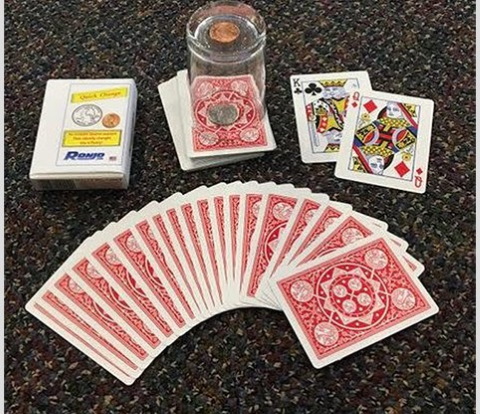
The deck is turned over to the other side (without the coin), and meanwhile, behind the scenes, the coin is thrown from one corner (with a magnet) to the other (without it) and fixed with the finger of the other hand holding the deck. In its natural form, the trick happens lightning fast and no one has time to detect the catch.
At the same time as the deck is turned over to the back side and the coin is moved, the film is removed in such a way that a gap is formed on the coin side, intended for its throwing off. To perform such a trick, time is needed to rehearse fast and technical movements.
Advice from professional masters of illusionary art always converges on 3 most important rules:
- show only well-rehearsed numbers;
- don't tell what will happen next, so that there is an element of surprise;
- Do not reveal the secrets of the tricks performed, otherwise the intrigue towards it will quickly dry up.
In particular, these rules apply to coin tricks as well. Following them will be a great help for beginners and children in establishing a new skill for the entertainment of others.
Author: Noah Jensen
Videos about magic tricks
Coin tricks:
